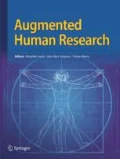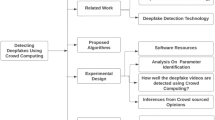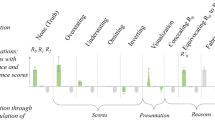Abstract
With terms like ‘fake news’ and ‘cyber attack’ dominating the news, skepticism toward the media and other online individuals has become a major facet of modern life. This paper views the way we process information during HCI through the lens of suspicion, a mentally taxing state that people enter before making a judgment about whether or not to trust information. With the goal of enabling objective, real-time measurements of suspicion during HCI, we describe an experiment where fNIRS was used to identify the neural correlates of suspicion in the brain. We developed a convolutional long short-term memory classifier that predicts suspicion using a leave-one-participant-out cross-validation scheme, with average accuracy greater than 76%. Notably, the brain regions implicated by our results dovetail with prior theoretical definitions of suspicion. We describe implications of this work for HCI, to augment users’ capabilities by enabling them to develop a ‘healthy skepticism’ to parse out truth from fiction online.






Similar content being viewed by others
Notes
This was the estimate included in prepared congressional testimony by Facebook on October 30, 2017.
We note concern about the measure of suspicion in this study—which was operationalized as the standard deviation (SD) of buyer price suggestions. That is, two different participants can experience the same SD across trials, yet the means of the suggested values could be lower for one seller (i.e., 1, 2, 3 have the same SD as 11, 12, 13)—and thus, different mean levels can be associated with different levels of suspicion (different levels of feelings of being taken advantage of).
References
Groys B (2012) Under Suspicion: a phenomenology of media. Columbia University Press, New York
Daniller A, Allen D, Tallevi A, Mutz D (2017) Measuring trust in the press in a changing media environment. Commun Methods Meas 11(1):76–85
Weeks B (2015) Emotions, partisanship, and misperceptions: how anger and anxiety moderate the effect of partisan bias on susceptibility to political misinformation. J Commun 65:699–719
Friedman B, Kahn PHJ, Howe C (2000) Trust online. Commun ACM 43(12):34–40
McEvily WJ, Wilson JM, Straus SG (2006) All in due time: the development of trust in electronic and face-to-face groups. Organ Behav Hum Decis Process 99:16–33
Toma C (2010) Perceptions of trustworthiness online: the role of visual and textual information. In: CSCW 2010, ACM, Savannah, Georgia, USA
Mitchell A, Gottfried J, Barthel M, Shearer E (2016) The Modern News Consumer News attitudes and practices in the digital era. Pew Research Center Report
Beldad A, de Jong M, Steehouder M (2010) How shall I trust the faceless and the intangible? A literature review on the antecedents of online trust. Comput Hum Behav 26:857–869
Shneiderman B (2000) Designing trust into online experiences. Commun ACM 43(12):57–59
Tversky A, Kahneman D (1974) Judgment under uncertainty: heuristics and biases. Science 185(4157):1124–1131
Parasuraman R, Manzey D (2010) Complacency and bias in human use of automation: an attentional integration. Hum Factors 52(3):381–410
IBM (2013) The 2013 IBM Cyber Security Intelligence Index
Hirshfield L, Bobko P, Barelka A, Costa M, Funke G, Mancuso V, Finomore V, Knott B (2015) The role of human operators’ suspicion in the detection of cyber attacks. Int J Cyber Warf Terror 5(3):28–44
Bean J (2017) The medium is the fake news. Interactions 24(3):24–25
Pogue D (2017) The ultimate cure for the fake news epidemic will be more skeptical readers. Scientific American
Colquitt J, Scott B, LePine J (2007) Trust, trustworthiness, and trust propensity: a meta-analytic test of their unique relationship with risk taking and job performance. J Appl Psychol 92(4):909–927
Bobko P, Barelka A, Hirshfield LM (2014) The construct of state-level suspicion: a model and research agenda for automated and information technology (IT) contexts. Hum Factors 56(3):489–508
Evans A, Revelle W (2008) Survey and behavioral measurements of interpersonal trust. J Res Pers 42:1585–1593
Mayer R, Davis J, Schoorman D (1995) An integrative model of organizational trust. Acad Manag Rev 20(3):709–734
Krueger F, McCabe K, Moll J, Kriegeskorte N, Zahn R, Strenziok M, Heinecke A, Grafman J (2007) Neural correlates of trust. The National Academy of Sciences of the USA. PNAS 104(50):20084–20089
Dimoka A (2010) What does the brain tell us about trust and distrust? Evidence from a functional neuroimaging study. Manag Inf Syst Q 34(2):373–396
Bhatt M, Lohrenz T, Camerer C, Montague R (2012) Distinct contributions of the amygdala and parahippocampal gyrus to suspicion in a repeated bargaining game. In: Proceedings of the National Academy of the Sciences of the United States of America
Watabe M, Hiroshi B, Yamamoto H (2011) Judgments about others’ trustworthiness: an fMRI study. Hum Behav Evol Soc Jpn 2(2):28–32
Craig A, Loureiro Y, Wood S, Vendemia J (2012) Suspicious minds: exploring neural processes during exposure to deceptive advertising. J Mark Res 49:361–372
Dimoka A (2012) How to conduct a functional magnetic resonance (fMRI) study in social science research. MIS Q 36(3):811–840
Medvedev A (2013) Shedding near-infrared light on brain networks. J Radiol Radiat Ther 1:1002
Gratton G, Fabiani F (2009) Fast optical signals: principles, methods, and experimental results. In: Frostig RD (ed) Cover of in vivo optical imaging of brain function in vivo optical imaging of brain function. Taylor and Francis, Routledge
Chance B, Zhuang Z, Chu U, Alter C, Lipton L (1993) Cognition activated low frequency modulation of light absorption in human brain. Proc Natl Acad Sci 90:2660–2774
Izzetoglu K, Bunce S, Onaral B, Pourrezaei K, Chance B (2004) Functional optical brain imaging using near-infrared during cognitive tasks. Int J Hum-Comput Interact 17(2):211–231
Hirshfield L, Gulotta R, Hirshfield S, Hincks S, Russell M, Williams T, Jacob R (2011) This is your brain on interfaces: enhancing usability testing with functional near infrared spectroscopy. In: SIGCHI. ACM
Solovey E, Girouard A, Chauncey K, Hirshfield L, Sassaroli A, Zheng F, Fantini S, Jacob R (2009) Using fNIRS brain sensing in realistic HCI settings: experiments and guidelines. In: ACM UIST symposium on user interface software and technology. ACM Press
Solovey E, Afergan D, Peck E, Hincks S, Jacob R (2015) Designing implicit interfaces for physiological computing: guidelines and lessons learned using fNIRS. ACM Trans Hum Comput Interact 21(6):35
Fairclough S (2009) Fundamentals of physiological computing. Interact Comput 21:133–145
Plácido Da Silva H, Fairclough S, Holzinger A, Jacob J, Tan D (2015) Introduction to the special issue on physiological computing for human–computer interaction. ACM Trans Hum Comput Interact 21(6):29
Tan D, Nijholt A (2010) Brain–computer interfaces: applying our minds to human–computer interaction. Springer, Berlin
Mandryk R, Atkins M, Inkpen K (2006) A continuous and objective evaluation of emotional experience with interactive play environments. In: Proceedings of the SIGCHI conference on human factors in computing systems. ACM Press, Montreal, Quebec, Canada
Poldrack RA (2006) Can cognitive processes be inferred from neuroimaging data? Trends Cogn Sci 10(2):59–63
Parasuraman R, Rizzo M (2008) Neuroergonomics: the brain at work. Oxford University Press, Oxford
Boas D, Elwell C, Ferrari M, Taga G (2014) Twenty years of functional near-infrared spectroscopy: introduction for the special issue. Neuroimage 15:1–5
Ferrari M, Quaresima V (2012) A brief review on the history of human functional near-infrared spectroscopy (fNIRS) development and fields of application. Neuroimage 63(2):921–935
Kruger F, Mccabe K, Moll J, Kriegeskorte N, Zahn R, Strenziok M, Heinecke A, Grafman J (2008) The neural correlates of trust. PNAS 104(50):20084–20089
Fett A, Gromann P, Giampietro V, Shergill S, Krabbendam L (2014) Default distrust? An fMRI investigation of the neural development of trust and cooperation. Soc Cogn Affect Neurosci 9(4):395–402
Sebastian C, Fontaine N, Bird G, Blakemore S, De Brito S, McCrory E, Viding E (2012) Neural processing associated with cognitive and affective Theory of Mind in adolescents and adults. Soc Cogn Affect Neurosci 7(1):53–63
Mahya C, Mosesa L, Pfeifera J (2014) How and where: theory-of-mind in the brain. Dev Cogn Neurosci 9:68–81
Etkin A, Egner T, Kalisch R (2011) Emotional processing in anterior cingulate and medial prefrontal cortex. Trends Cogn Sci 15(2):85–93
Golkar A, Lonsdorf TB, Olsson A, Lindstrom KM, Berrebi J, Fransson P, Schalling M, Ingvar M, Öhman A (2012) Distinct contributions of the dorsolateral prefrontal and orbitofrontal cortex during emotion regulation. PLoS ONE 7:e48107
Niendam T, Laird A, Ray K, Dean M, Glahn D, Carter C (2012) Meta-analytic evidence for a superordinate cognitive control network subserving diverse executive functions. Cogn Affect Behav Neurosci 12(2):241–268
Green M, Horan W, Lee J (2015) Social cognition in schizophrenia. Nat Rev Neurosci 16(10):620–631
Lavin C, Melis C, Mikulan E, Gelormini C, Huepe D, Ibanez A (2013) The anterior cingulate cortex: an integrative hub for human socially-driven interactions. Front Neurosci 7:64
Xiang T, Lohrenz T (2013) Computational substrates of norms and their violations during social exchange. J Neurosci 33(3):1099–1108
Krain A, Wilson AM, Arbuckle R, Castellanos FX, Milham MP (2006) Distinct neural mechanisms of risk and ambiguity: a meta-analysis of decision-making. Neuroimage 32(1):477–484
Saxe R, Kanwisher N (2003) People thinking about thinking people: the role of the temporo-parietal junction in “theory of mind”. NeuroImage 19(4):1835–1842
Koster-Hale J, Saxe R (2013) Functional neuroimaging of theory of mind. In: Understanding other minds: perspectives from developmental social neuroscience, Oxford Scholarship Online
Ciaramidaro A, Adenzato M, Enrici I, Erk S, Pia L, Bara B, Walte H (2007) The intentional network: How the brain reads varieties of intentions. Neuropsychologia 45:3105–3113
Brunet E, Sarfati Y (2000) A PET investigation of the attribution of intentions with a nonverbal task. Neuroimage 11:157–166
Aimone J, DHouser D, Weber B (2014) Neural signatures of betrayal aversion: an fMRI study of trust. In: Proceedings of the royal society of biological sciences
Tang H, Mai X, Wang S, Zhu C, Krueger F, Liu C (2015) Interpersonal brain synchronization in the right temporo-parietal junction during face-to-face economic exchange. Soc Cogn Affect Neurosci 11:23–32
Hahn T, Notebaert K, Anderl C, Teckentrup V, Kaßecker A, Windmann S (2015) How to trust a perfect stranger: predicting initial trust behavior from resting-state brain-electrical connectivity. Soc Cogn Affect Neurosci 10(6):809–813
Rudoy J, Paller K (2003) Who can you trust? Behavioral and neural differences between perceptual and memory-based influences. Front Hum Neurosci 3:16
Ma Q, Meng L, Qiang S (2015) You have my word: reciprocity expectation modulates feedback-related negativity in the trust game. PLOS One 10(2):e0119129
Wang Y, Zhang Z, Jing Y, Valadez E, Simons R (2016) How do we trust strangers? The neural correlates of decision making and outcome evaluation of generalized trust. Soc Cogn Affect Neurosci 11:1666–1676
Ferraz P, Millan J (2005) You are wrong!—Automatic detection of interaction errors from brain waves. In: Proceedings of the 19th international joint conference on artificial intelligence, pp 1413–1418
Hajcak G, McDonald N, Simons R (2004) Error-related psychophysiology and negative affect. Brain Cogn 56(2):189–197
Vi C, Subramanian S (2012) Detecting error-related negativity for interaction design. In: Proceedings of the SIGCHI conference on human factors in computing systems (CHI ‘12)
Lafferty JC, Eady P, Elmers J (1974) The desert survival problem
Hart SG, Staveland LE (1988) Development of NASA-TLX (Task Load Index): results of empirical and theoretical research. In: Hancock P, Meshkati N (eds) Human mental workload. North Holland, Amsterdam, pp 139–183
Bracley M, Lang PJ (1994) Measuring emotion: the self-assessment manikin and the semantic differential. J Behav Ther Exp Psychiatry 25(1):49–59
Ye JC, Tak S, Jang KE, Jung J, Jang J (2009) NIRS-SPM: statistical parametric mapping for near-infrared spectroscopy. Neuroimage 44(2):428–447
Burgoon JK, Blair P, Strom R (2008) Cognitive biases and nonverbal cue availability in detecting deception. Hum Commun Res 34(4):572–599
Shneiderman B, Plaisant C (2005) Designing the user interface: strategies for effective human-computer interaction, 4th edn. Addison-Wesley, Reading
Adamczyk P, Bailey B (2004) If not now, when?: The effects of interruption at different moments within task execution. In: Proceedings of the SIGCHI conference on human factors in computing systems (CHI ‘04). ACM
Chawya N, Bowyer K, Hall L, Kegelmeyer W (2002) SMOTE: synthetic minority over-sampling technique. J Artif Intell Res 16:321–357
Seiffert C, Khoshgoftaar T, Van Hulse J, Napolitano A (2010) RUSBoost: a Hybrid Approach to Alleviating Class Imbalance. IEEE Trans Syst Man Cybern A Syst Hum 40(1):185–197
Acknowledgements
We would like to thank the Air Force Research Laboratory and the Air Force Office of Sponsored Research (FA9550-15-1-0021) for sponsoring this research.
Author information
Authors and Affiliations
Corresponding author
Ethics declarations
Conflict of interest
On behalf of all authors, the corresponding author states that there is no conflict of interest.
Additional information
Publisher's Note
Springer Nature remains neutral with regard to jurisdictional claims in published maps and institutional affiliations.
Rights and permissions
About this article
Cite this article
Hirshfield, L., Bobko, P., Barelka, A. et al. Toward Interfaces that Help Users Identify Misinformation Online: Using fNIRS to Measure Suspicion. Augment Hum Res 4, 1 (2019). https://doi.org/10.1007/s41133-019-0011-8
Received:
Accepted:
Published:
DOI: https://doi.org/10.1007/s41133-019-0011-8




